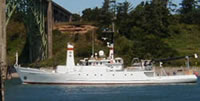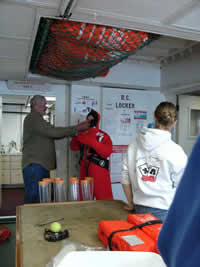


|
The Project Part 3:
Also See: Part 1: Part 2:
|
August 30, 2005
We're Off and Running! This morning the Wecoma left Newport, Oregon under clear blue skies heading for our destination. We are traveling 600 kilometers off shore to 41.5 degrees north, 132 degrees west, also known as Gyre. This morning, as well as yesterday, everyone was busy getting ready and taking care of last minute details. The scientists have to be certain that everything is in working order. It would be a waste of resources to be out to sea and not be able to complete the experiments they need. The crew is also busy making sure we are ship shape. We have all our instruments in working order, fresh linens, cleaning supplies, and, most importantly, plenty of fresh water and good food. The most exciting part of my morning was the safety presentation and learning how to put on a rubber survival suit. I'm definitely feeling the effects of the sea, so my journal may be a little short. For those of you who, like me, have never been to sea, I find it is much better to be out on the deck than it is to be inside the lab. Last night was the first time I've ever slept on water, unless you count that time as a kid I got to sleep on Uncle Steve's waterbed. It's strange to feel yourself moving, but open your eyes and not see anything moving. I'm living in a floating house. The R/V Wecoma is 184.5 feet long and has three decks. As we head out to our location, we are traveling at 12 knots, or 12 nautical miles per hour, which is the cruising speed of this ship. There are all kinds of new measurement words for me to learn: fathom and league are just two of them. I found out that a fathom is six feet in length, while a league is three nautical miles. Nautical miles are measured over water and are a little bit longer than the miles your car measures on your odometer as you drive. Math Questions: If the water we were docked in last night was 35 feet deep, how many fathoms is that? Many of you have read the book, or seen the movie, 20,000 Leagues Under the Sea. How many miles down would that be? Is that a realistic number? Just for fun, do an internet search and look up the Mariana Trench, which is the deepest spot in the ocean we know. How deep is it? Now does 20,000 leagues seem reasonable? Ocean Trivia: Sailors used to measure depth by throwing a line overboard until it hit bottom. Then they would bring it back in measuring the length of the line from finger tip to finger tip. The arm span of the average sailor was six feet and called a fathom.
|


